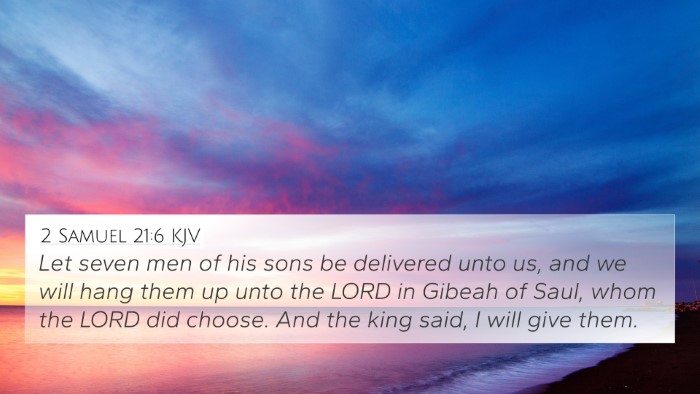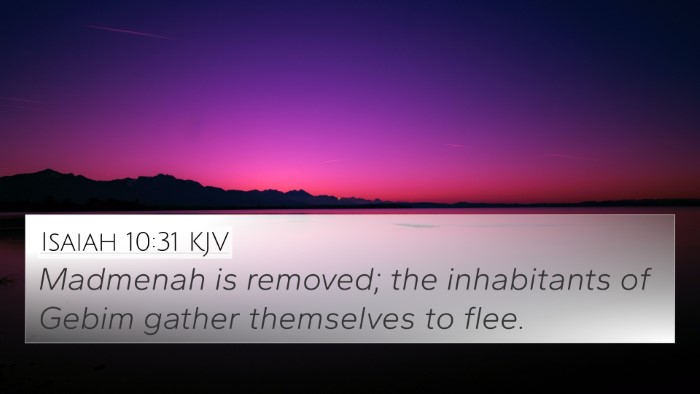Understanding 1 Chronicles 2:49
1 Chronicles 2:49 states, "And she bare Saul, and these are the names of the men of her house."
This verse highlights the genealogy and importance of key figures in the history of Israel.
The verse relates specifically to the lineage of David and connects with the broader narrative of Israel’s monarchy.
Summary of Insights
The verse provides a glimpse into the genealogical records essential for establishing the credentials
of individuals playing pivotal roles in biblical narratives, particularly in relation to the lineage of
King David and eventually Jesus Christ. Various public domain commentaries shed light on its significance.
Commentary Highlights
-
Matthew Henry's Commentary:
This verse illustrates the importance of genealogy in the Bible, emphasizing how it serves not only
as a historical record but also as a narrative device to validate God’s promises. The mention of Saul
represents significant transitions in leadership amongst the Israelite people, ultimately leading
to the establishment of the Davidic line.
-
Albert Barnes' Notes:
Barnes points out that the genealogy presented here connects the historical narrative of the Israelites,
showcasing the line from Judah to Saul and highlighting the importance of family heritage in the scripture.
The verse acts as a bridge connecting the personalities pivotal to Israel’s history.
-
Adam Clarke’s Commentary:
Clarke elaborates on how the genealogical records establish authority and identity within the Israelite communities.
The mention of Saul reinforces the idea that the lineage plays a role in divine selection and covenant history,
pointing toward the overarching narrative of God’s dealings with humanity through covenants.
Bible Verse Cross-References
This verse connects with several other scriptures, providing deeper insights and thematic ties:
- 1 Samuel 9:1-2: This passage introduces Saul as a key figure from the tribe of Benjamin,
establishing him as Israel's first king.
- Matthew 1:6: Acknowledges David's lineage, which includes both Jesse and Solomon.
- Luke 3:33: Provides another lineage that illustrates the connection to David.
- 1 Chronicles 2:15-16: Lists the sons of Jesse, tying back to David's ancestry.
- Genesis 49:10: Prophesies the scepter shall not depart from Judah, linking to Saul's establishment.
- Romans 1:3: Highlights how Jesus Christ is a descendant of David, connecting back to 1 Chronicles.
- Hebrews 7:14: Mentions Jesus coming from the tribe of Judah, fulfilling the prophecies regarding David's lineage.
Connections Between Bible Verses
The connections derived from 1 Chronicles 2:49 not only illustrate the genealogical importance but also enhance
our understanding of biblical themes such as leadership, divine appointment, and covenant continuity.
The interplay between the Old and New Testament narratives concerning lineage brings to light how God’s plan
unfolds through generations.
Cross-Referencing Biblical Texts
Using tools for Bible cross-referencing enhances our understanding of the scriptures, aiding in identifying
themes, characters, and divine plans through history. Employing a Bible concordance or cross-reference guide can facilitate deep studies.
How to Use Bible Cross-References
- Utilize a Bible concordance to find related verses based on key themes.
- Engage in cross-reference Bible study to explore interconnections.
- Apply Bible reference resources for comprehensive studies.
- Employ cross-referencing Bible study methods for theological research.
Conclusion
In summarizing 1 Chronicles 2:49, its genealogical significance, connections with other biblical texts,
and its implications for understanding God's continued work through history becomes evident.
This lineage is not just a historical account but a template for understanding faith, prophecy, and divine
sovereignty as manifested throughout the Bible.







